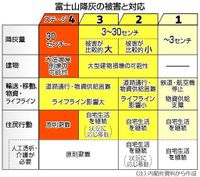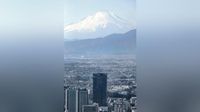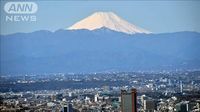A panel of experts convened by the Cabinet Office of Japan has released a significant report outlining recommendations for the Tokyo metropolitan area's response to a potential large-scale eruption of Mount Fuji, which could lead to widespread ashfall. The guidelines, released on March 21, 2025, categorize the risks to residents based on the amount of ashfall and emphasize the importance of preparedness in the face of such a natural disaster.
According to the report, if volcanic ashfall is less than 30 centimeters, residents in affected areas should primarily continue to live at home. However, when ash accumulation reaches 30 centimeters or more, the likelihood of structural damage, particularly to wooden houses due to added weight from rain, necessitates evacuation to safer areas.
Mount Fuji is an active volcano known for its historical eruptions, with records indicating it has erupted approximately 180 times over the last 5,600 years. Notably, it has remained dormant for over 300 years since the Hoei eruption in 1707, making the current assessments all the more significant. A 2020 report from the Central Disaster Management Council indicated that if a major eruption were to occur, ash would fall across 11 prefectures, with specific estimates of over three centimeters near Shinjuku in Tokyo and over 30 centimeters in areas such as Sagamihara.
Minoru Fujii, the chairman of the panel and Professor Emeritus at the University of Tokyo, spoke about the profound implications of such an event: "Volcanic ash is a phenomenon that can cause damage even at a distance, such as in the Tokyo metropolitan area," highlighting the risks associated with ashfall.
The report also states that even in zones with ashfall less than 30 centimeters, it is critical to stockpile essential supplies like food and water to last at least two weeks, as disruptions to lifelines, such as electricity, water supply, and transportation, are likely. It emphasizes the need for residents to prepare in advance, particularly urging those who require medical assistance—such as patients needing dialysis—to evacuate early if they are in areas facing significant ash accumulation.
The guidelines categorize situations into four distinct stages of ashfall, allowing for a structured response. Stage 1 corresponds to trace amounts up to three centimeters, where residents are encouraged to remain at home; Stage 2 includes ashfall of three to 30 centimeters with minor damage considerations; and Stage 3, with the same ashfall range, recognizes the potential for significant damage. Stage 4 indicates ashfall of 30 centimeters or more, mandating evacuation.
Japan's government is treating the management of volcanic ash with utmost seriousness, as experts predict that the volume of ash could reach approximately 4.9 billion cubic meters in a worst-case scenario—ten times the disaster waste produced by the Great East Japan Earthquake. This staggering figure underscores the urgent need for effective ash disposal strategies. To mitigate disruptions, the report urges local governments and infrastructure agencies to prioritize the clearing of roads and railways affected by ash buildup.
In light of these projections, community preparedness measures are vital. The report stresses that complacency could lead to catastrophic consequences, with Fujii urging that residents ought to prepare proactively rather than reactively, as planning cannot begin after an eruption has commenced. He stated, "Preparation and public understanding are not progressing," as widespread ashfall is a phenomenon that has rarely impacted modern Japan.
Additionally, guidelines for managing the disposal of massive ash accumulations were addressed. Various methods—including temporary storage, recycling, landfill, and ocean disposal—have been proposed, with an emphasis on the collaboration between local and national authorities to ensure proper preparation and execution of these measures. The overarching message is clear: delaying preparation could result in avoidable hardship.
In tandem with these plans, the Meteorological Agency is exploring the possibility of issuing warnings in the event of an imminent eruption and ashfall predictions exceeding three centimeters. This threshold is deemed critical for ensuring that local governments can respond effectively by facilitating evacuations and managing safety protocols.
As discussions surrounding disaster preparedness continue, there is a strong emphasis on public education regarding the nature and risks associated with volcanic eruptions, particularly for those living in densely populated urban areas near active volcanoes. The need for robust and clear communication regarding the expected impacts of ashfall, as well as the actions residents should take, is paramount.
Ultimately, the Cabinet Office's report serves as a blueprint for safeguarding the Tokyo metropolitan area against the impactful repercussions of a volcanic eruption, calling for readiness and resilience against a natural disaster that, if not adequately prepared for, threatens to disrupt lives and livelihoods across the region. The community's understanding of these measures is critical for effective disaster response and recovery.







